Ideal Bond Angle For Tetrahedral
v.2: Molecular Shape
- Page ID
- 112686
Skills to Develop
- Predict the structures of small-scale molecules using valence shell electron pair repulsion (VSEPR) theory
Thus far, we have used two-dimensional Lewis structures to represent molecules. However, molecular structure is actually three-dimensional, and it is of import to exist able to describe molecular bonds in terms of their distances, angles, and relative arrangements in space (Figure \(\PageIndex{ane}\)). A bail angle is the angle between any two bonds that include a mutual atom, usually measured in degrees. A bond distance (or bond length) is the distance between the nuclei of 2 bonded atoms along the direct line joining the nuclei. Bond distances are measured in Ångstroms (one Å = ten–ten grand) or picometers (i pm = 10–12 m, 100 pm = ane Å).
Figure \(\PageIndex{1}\): Bond distances (lengths) and angles are shown for the formaldehyde molecule, HiiCO.
VSEPR Theory
Valence trounce electron-pair repulsion theory (VSEPR theory) enables us to predict the molecular construction, including approximate bond angles around a central atom, of a molecule from an test of the number of bonds and lone electron pairs in its Lewis construction. The VSEPR model assumes that electron pairs in the valence shell of a central atom will adopt an arrangement that minimizes repulsions between these electron pairs by maximizing the distance betwixt them. The electrons in the valence beat out of a central atom form either bonding pairs of electrons, located primarily between bonded atoms, or lone pairs. The electrostatic repulsion of these electrons is reduced when the various regions of high electron density presume positions equally far from each other as possible.
VSEPR theory predicts the arrangement of electron pairs around each key cantlet and, ordinarily, the correct arrangement of atoms in a molecule. Nosotros should sympathize, still, that the theory only considers electron-pair repulsions. Other interactions, such as nuclear-nuclear repulsions and nuclear-electron attractions, are as well involved in the terminal arrangement that atoms adopt in a item molecular structure.
As a simple example of VSEPR theory, permit u.s.a. predict the structure of a gaseous BeF2 molecule. The Lewis structure of BeF2 (Figure \(\PageIndex{ii}\)) shows only two electron pairs effectually the key beryllium cantlet. With two bonds and no solitary pairs of electrons on the primal cantlet, the bonds are as far apart as possible, and the electrostatic repulsion between these regions of high electron density is reduced to a minimum when they are on opposite sides of the central atom. The bail angle is 180° (Figure \(\PageIndex{two}\)).
Figure \(\PageIndex{2}\): The BeFtwo molecule adopts a linear structure in which the two bonds are as far apart as possible, on opposite sides of the Exist atom.
Figure \(\PageIndex{3}\) illustrates this and other electron-pair geometries that minimize the repulsions among regions of high electron density (bonds and/or lonely pairs). Two regions of electron density around a central cantlet in a molecule grade a linear geometry; three regions form a trigonal planar geometry; four regions grade a tetrahedral geometry; v regions class a trigonal bipyramidal geometry; and six regions course an octahedral geometry.
Figure \(\PageIndex{3}\): The basic electron-pair geometries predicted by VSEPR theory maximize the space around whatsoever region of electron density (bonds or lone pairs).
Electron-pair Geometry versus Molecular Structure
It is important to note that electron-pair geometry around a central atom is not the same matter as its molecular structure. The electron-pair geometries shown in Figure \(\PageIndex{3}\) depict all regions where electrons are located, bonds besides as lone pairs. Molecular structure describes the location of the atoms, non the electrons.
We differentiate between these two situations by naming the geometry that includes all electron pairs the electron-pair geometry. The structure that includes only the placement of the atoms in the molecule is called the molecular structure. The electron-pair geometries volition be the same as the molecular structures when there are no lone electron pairs effectually the key atom, only they volition be different when at that place are lone pairs present on the fundamental cantlet.
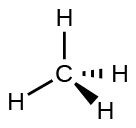
Figure \(\PageIndex{four}\): The molecular structure of the methane molecule, CH4, is shown with a tetrahedral organisation of the hydrogen atoms. VSEPR structures similar this ane are often drawn using the wedge and dash notation, in which solid lines represent bonds in the plane of the page, solid wedges represent bonds coming up out of the airplane, and dashed lines represent bonds going down into the plane.
For example, the methane molecule, CH4, which is the major component of natural gas, has 4 bonding pairs of electrons effectually the central carbon cantlet; the electron-pair geometry is tetrahedral, equally is the molecular construction (Effigy \(\PageIndex{four}\)). On the other paw, the ammonia molecule, NHthree, also has 4 electron pairs associated with the nitrogen atom, and thus has a tetrahedral electron-pair geometry. One of these regions, however, is a lone pair, which is not included in the molecular construction, and this lone pair influences the shape of the molecule (Figure \(\PageIndex{5}\)).
Effigy \(\PageIndex{5}\): (a) The electron-pair geometry for the ammonia molecule is tetrahedral with one lonely pair and three single bonds. (b) The trigonal pyramidal molecular structure is determined from the electron-pair geometry. (c) The bodily bond angles deviate slightly from the idealized angles because the lone pair takes up a larger region of space than do the unmarried bonds, causing the HNH bending to be slightly smaller than 109.v°.
Small distortions from the platonic angles in Figure \(\PageIndex{five}\) tin can result from differences in repulsion between diverse regions of electron density. VSEPR theory predicts these distortions by establishing an order of repulsions and an order of the amount of space occupied past different kinds of electron pairs. The lodge of electron-pair repulsions from greatest to to the lowest degree repulsion is:
lone pair-lone pair > solitary pair-bonding pair > bonding pair-bonding pair
This order of repulsions determines the corporeality of space occupied by different regions of electrons. A lone pair of electrons occupies a larger region of space than the electrons in a triple bail; in plow, electrons in a triple bail occupy more than infinite than those in a double bond, and and then on. The order of sizes from largest to smallest is:
lone pair > triple bond > double bond > single bond
Consider formaldehyde, H2CO, which is used as a preservative for biological and anatomical specimens. This molecule has regions of high electron density that consist of ii single bonds and one double bond. The basic geometry is trigonal planar with 120° bond angles, but we encounter that the double bond causes slightly larger angles (121°), and the bending betwixt the unmarried bonds is slightly smaller (118°).
In the ammonia molecule, the three hydrogen atoms attached to the central nitrogen are not arranged in a flat, trigonal planar molecular structure, merely rather in a three-dimensional trigonal pyramid (Effigy \(\PageIndex{six}\)) with the nitrogen atom at the apex and the three hydrogen atoms forming the base of operations. The ideal bail angles in a trigonal pyramid are based on the tetrahedral electron pair geometry. Once again, there are slight deviations from the platonic considering solitary pairs occupy larger regions of space than do bonding electrons. The H–Northward–H bond angles in NH3 are slightly smaller than the 109.5° angle in a regular tetrahedron (Figure \(\PageIndex{six}\)) because the lonely pair-bonding pair repulsion is greater than the bonding pair-bonding pair repulsion. The ideal molecular structures are predicted based on the electron-pair geometries for various combinations of lone pairs and bonding pairs.
Figure \(\PageIndex{vi}\): The molecular structures are identical to the electron-pair geometries when in that location are no lone pairs present (first column). For a particular number of electron pairs (row), the molecular structures for one or more lonely pairs are determined based on modifications of the respective electron-pair geometry.
Co-ordinate to VSEPR theory, the concluding atom locations (Xs in Figure \(\PageIndex{seven}\)) are equivalent within the linear, trigonal planar, and tetrahedral electron-pair geometries (the first three rows of the table). It does not thing which X is replaced with a lone pair considering the molecules tin can be rotated to catechumen positions. For trigonal bipyramidal electron-pair geometries, withal, there are two distinct X positions (Figure \(\PageIndex{seven}\)a): an centric position (if nosotros hold a model of a trigonal bipyramid by the two centric positions, nosotros have an axis around which we can rotate the model) and an equatorial position (three positions form an equator effectually the middle of the molecule). The axial position is surrounded by bond angles of xc°, whereas the equatorial position has more than space bachelor because of the 120° bond angles. In a trigonal bipyramidal electron-pair geometry, alone pairs ever occupy equatorial positions because these more spacious positions can more easily accommodate the larger lone pairs.
Theoretically, nosotros can come up with iii possible arrangements for the iii bonds and ii lonely pairs for the ClF3 molecule (Figure \(\PageIndex{7}\)). The stable construction is the one that puts the lone pairs in equatorial locations, giving a T-shaped molecular structure.
Effigy \(\PageIndex{seven}\): (a) In a trigonal bipyramid, the 2 axial positions are located directly across from one another, whereas the 3 equatorial positions are located in a triangular arrangement. (b–d) The two lone pairs (ruby-red lines) in ClF3 accept several possible arrangements, only the T-shaped molecular construction (b) is the one actually observed, consistent with the larger lone pairs both occupying equatorial positions.
When a central atom has two solitary electron pairs and 4 bonding regions, we have an octahedral electron-pair geometry. The 2 alone pairs are on opposite sides of the octahedron (180° apart), giving a foursquare planar molecular structure that minimizes lone pair-lone pair repulsions.
Predicting Electron Pair Geometry and Molecular Structure
The following procedure uses VSEPR theory to determine the electron pair geometries and the molecular structures:
- Write the Lewis structure of the molecule or polyatomic ion.
- Count the number of regions of electron density (lonely pairs and bonds) around the central atom. A single, double, or triple bail counts every bit 1 region of electron density.
- Identify the electron-pair geometry based on the number of regions of electron density: linear, trigonal planar, tetrahedral, trigonal bipyramidal, or octahedral (Effigy \(\PageIndex{vii}\), commencement column).
- Apply the number of lone pairs to determine the molecular structure (Figure \(\PageIndex{7}\) ). If more than than ane arrangement of lone pairs and chemical bonds is possible, choose the one that will minimize repulsions, remembering that alone pairs occupy more infinite than multiple bonds, which occupy more infinite than single bonds. In trigonal bipyramidal arrangements, repulsion is minimized when every solitary pair is in an equatorial position. In an octahedral arrangement with two lone pairs, repulsion is minimized when the lone pairs are on opposite sides of the fundamental atom.
The following examples illustrate the employ of VSEPR theory to predict the molecular structure of molecules or ions that have no lone pairs of electrons. In this case, the molecular construction is identical to the electron pair geometry.
Instance \(\PageIndex{1}\): Predicting Electron-pair Geometry and Molecular Construction
Predict the electron-pair geometry and molecular construction for each of the following:
- carbon dioxide, CO2, a molecule produced by the combustion of fossil fuels
- boron trichloride, BClthree, an of import industrial chemical
Solution
(a) We write the Lewis structure of CO2 as:

This shows us two regions of loftier electron density effectually the carbon atom—each double bail counts as 1 region, and there are no lone pairs on the carbon atom. Using VSEPR theory, we predict that the two regions of electron density arrange themselves on opposite sides of the central cantlet with a bond angle of 180°. The electron-pair geometry and molecular construction are identical, and CO2 molecules are linear.
(b) We write the Lewis structure of BCl3 as:
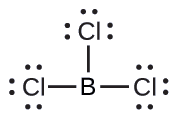
Thus we see that BCliii contains three bonds, and there are no lonely pairs of electrons on boron. The organisation of three regions of high electron density gives a trigonal planar electron-pair geometry. The B–Cl bonds lie in a plane with 120° angles between them. BCl3 also has a trigonal planar molecular construction.

The electron-pair geometry and molecular structure of BCl3 are both trigonal planar. Note that the VSEPR geometry indicates the correct bail angles (120°), dissimilar the Lewis structure shown above.
Exercise \(\PageIndex{ane}\)
Carbonate,
- Reply
-
The electron-pair geometry is trigonal planar and the molecular structure is trigonal planar. Due to resonance, all iii C–O bonds are identical. Whether they are single, double, or an average of the two, each bond counts as one region of electron density.
Instance \(\PageIndex{ii}\): Predicting Electron-pair Geometry and Molecular Construction
Two of the tiptop 50 chemicals produced in the United states of america, ammonium nitrate and ammonium sulfate, both used as fertilizers, comprise the ammonium ion. Predict the electron-pair geometry and molecular structure of the
Solution
We write the Lewis structure of
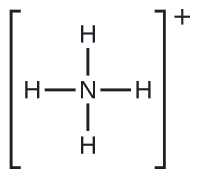
Nosotros can come across that \(\ce{NH4+}\)

Effigy \(\PageIndex{8}\): The ammonium ion displays a tetrahedral electron-pair geometry too every bit a tetrahedral molecular structure.
Exercise \(\PageIndex{2}\)
Place a molecule with trigonal bipyramidal molecular structure.
- Respond
-
Whatsoever molecule with five electron pairs around the central atoms including no lone pairs volition exist trigonal bipyramidal. \(\ce{PF5}\) is a common example
The next several examples illustrate the outcome of alone pairs of electrons on molecular structure.
Example \(\PageIndex{3}\): Lone Pairs on the Central Atom
Predict the electron-pair geometry and molecular structure of a h2o molecule.
Solution
The Lewis structure of H2O indicates that there are four regions of high electron density effectually the oxygen atom: ii lone pairs and two chemical bonds:
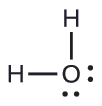
We predict that these four regions are arranged in a tetrahedral fashion (Figure \(\PageIndex{half-dozen}\)), as indicated in Effigy \(\PageIndex{ix}\). Thus, the electron-pair geometry is tetrahedral and the molecular structure is bent with an angle slightly less than 109.five°. In fact, the bond angle is 104.5°.
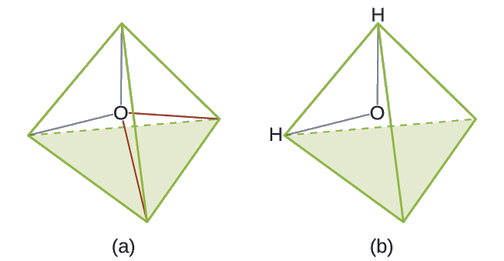
Figure \(\PageIndex{9}\) : (a) HiiO has four regions of electron density effectually the primal atom, then it has a tetrahedral electron-pair geometry. (b) Two of the electron regions are lone pairs, so the molecular structure is bent.
Exercise \(\PageIndex{3}\)
The hydronium ion, H3O+, forms when acids are dissolved in h2o. Predict the electron-pair geometry and molecular structure of this cation.
- Reply
-
electron pair geometry: tetrahedral; molecular construction: trigonal pyramidal
Example \(\PageIndex{4}\): SF4 Sulfur tetrafluoride,
Predicting Electron-pair Geometry and Molecular Structure: SF4, is extremely valuable for the preparation of fluorine-containing compounds used equally herbicides (i.e., SF4 is used equally a fluorinating agent). Predict the electron-pair geometry and molecular structure of a SFiv molecule.
Solution
The Lewis structure of SFfour indicates five regions of electron density effectually the sulfur atom: i lone pair and iv bonding pairs:
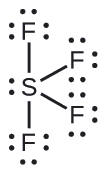
We await these 5 regions to prefer a trigonal bipyramidal electron-pair geometry. To minimize lone pair repulsions, the lone pair occupies one of the equatorial positions. The molecular construction (Figure \(\PageIndex{half dozen}\)) is that of a seesaw (Figure \(\PageIndex{x}\)).

Figure \(\PageIndex{10}\): (a) SFfour has a trigonal bipyramidal arrangement of the five regions of electron density. (b) One of the regions is a lone pair, which results in a seesaw-shaped molecular structure.
Do \(\PageIndex{4}\)
Predict the electron pair geometry and molecular structure for molecules of XeF2.
- Answer
-
The electron-pair geometry is trigonal bipyramidal. The molecular structure is linear.
Example \(\PageIndex{4}\): XeF4
Of all the noble gases, xenon is the well-nigh reactive, frequently reacting with elements such equally oxygen and fluorine. Predict the electron-pair geometry and molecular structure of the XeF4 molecule.
Solution
The Lewis structure of XeF4 indicates vi regions of high electron density around the xenon atom: two lone pairs and four bonds:

These half-dozen regions adopt an octahedral arrangement (Figure \(\PageIndex{6}\)), which is the electron-pair geometry. To minimize repulsions, the lone pairs should be on opposite sides of the central atom (Figure \(\PageIndex{xi}\)). The five atoms are all in the same plane and have a square planar molecular structure.
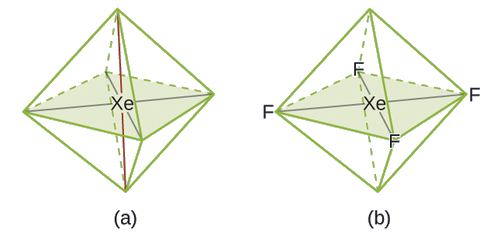
Effigy \(\PageIndex{11}\): (a) XeFiv adopts an octahedral arrangement with two lone pairs (carmine lines) and four bonds in the electron-pair geometry. (b) The molecular structure is square planar with the lone pairs directly beyond from ane some other.
Practise \(\PageIndex{4}\)
In a certain molecule, the key cantlet has three solitary pairs and two bonds. What volition the electron pair geometry and molecular structure be?
- Answer
-
electron pair geometry: trigonal bipyramidal; molecular structure: linear
Video \(\PageIndex{1}\): An overview of simple molecular shapes.
Molecular Structure for Multicenter Molecules
When a molecule or polyatomic ion has only one central atom, the molecular construction completely describes the shape of the molecule. Larger molecules practice not have a single central atom, but are continued past a concatenation of interior atoms that each possess a "local" geometry. The fashion these local structures are oriented with respect to each other also influences the molecular shape, but such considerations are largely across the telescopic of this introductory discussion. For our purposes, we volition only focus on determining the local structures.
Instance \(\PageIndex{5}\): Predicting Construction in Multicenter Molecules
The Lewis construction for the simplest amino acid, glycine, H2NCH2CO2H, is shown here. Predict the local geometry for the nitrogen atom, the two carbon atoms, and the oxygen atom with a hydrogen cantlet attached:

Solution

Consider each central cantlet independently. The electron-pair geometries:
- nitrogen––4 regions of electron density; tetrahedral
- carbon (CH2)––iv regions of electron density; tetrahedral
- carbon (CO2)—three regions of electron density; trigonal planar
- oxygen (OH)—four regions of electron density; tetrahedral
The local structures:
- nitrogen––three bonds, one alone pair; trigonal pyramidal
- carbon (CH2)—iv bonds, no lone pairs; tetrahedral
- carbon (CO2)—3 bonds (double bond counts as one bond), no lone pairs; trigonal planar
- oxygen (OH)—ii bonds, ii lone pairs; bent (109°)
Do \(\PageIndex{v}\)
Another amino acid is alanine, which has the Lewis structure shown here. Predict the electron-pair geometry and local construction of the nitrogen atom, the three carbon atoms, and the oxygen atom with hydrogen attached:
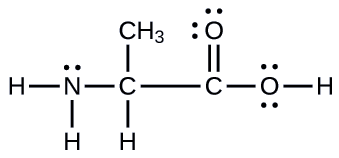
- Answer
-
electron-pair geometries: nitrogen––tetrahedral; carbon (CH)—tetrahedral; carbon (CHiii)—tetrahedral; carbon (CO2)—trigonal planar; oxygen (OH)—tetrahedral; local structures: nitrogen—trigonal pyramidal; carbon (CH)—tetrahedral; carbon (CH3)—tetrahedral; carbon (CO2)—trigonal planar; oxygen (OH)—bent (109°)
Case \(\PageIndex{6}\): Molecular Simulation
Using this molecular shape simulator allows united states to control whether bond angles and/or solitary pairs are displayed by checking or unchecking the boxes under "Options" on the right. Nosotros can also use the "Name" checkboxes at bottom-left to display or hibernate the electron pair geometry (called "electron geometry" in the simulator) and/or molecular structure (called "molecular shape" in the simulator).
Build the molecule HCN in the simulator based on the following Lewis structure:
Click on each bond type or lone pair at right to add that group to the central atom. One time you have the complete molecule, rotate information technology to examine the predicted molecular structure. What molecular structure is this?
Solution
The molecular structure is linear.
Exercise \(\PageIndex{6}\)
Build a more complex molecule in the simulator. Identify the electron-group geometry, molecular structure, and bond angles. Then try to find a chemical formula that would lucifer the structure y'all take drawn.
- Answer
-
Answers will vary. For example, an atom with iv single bonds, a double bond, and a lone pair has an octahedral electron-group geometry and a square pyramidal molecular structure. XeOF4 is a molecule that adopts this structure.
Summary
Video \(\PageIndex{2}\): What is the shape of a molecule?
VSEPR theory predicts the three-dimensional arrangement of atoms in a molecule. Information technology states that valence electrons will assume an electron-pair geometry that minimizes repulsions betwixt areas of high electron density (bonds and/or lone pairs). Molecular construction, which refers only to the placement of atoms in a molecule and not the electrons, is equivalent to electron-pair geometry only when at that place are no lone electron pairs around the central atom.
Glossary
- axial position
- location in a trigonal bipyramidal geometry in which there is another atom at a 180° angle and the equatorial positions are at a 90° angle
- bond angle
- bending between any two covalent bonds that share a common atom
- bond distance
- (besides, bond length) altitude between the nuclei of 2 bonded atoms
- bail dipole moment
- separation of accuse in a bond that depends on the deviation in electronegativity and the bail altitude represented by partial charges or a vector
- dipole moment
- property of a molecule that describes the separation of charge determined by the sum of the individual bail moments based on the molecular structure
- electron-pair geometry
- arrangement around a central atom of all regions of electron density (bonds, lone pairs, or unpaired electrons)
- equatorial position
- one of the three positions in a trigonal bipyramidal geometry with 120° angles betwixt them; the axial positions are located at a xc° angle
- linear
- shape in which two outside groups are placed on opposite sides of a central atom
- molecular structure
- structure that includes only the placement of the atoms in the molecule
- octahedral
- shape in which six outside groups are placed around a central atom such that a three-dimensional shape is generated with four groups forming a square and the other two forming the apex of ii pyramids, one to a higher place and one below the foursquare plane
- polar molecule
- (likewise, dipole) molecule with an overall dipole moment
- tetrahedral
- shape in which four exterior groups are placed around a central atom such that a three-dimensional shape is generated with four corners and 109.5° angles between each pair and the central atom
- trigonal bipyramidal
- shape in which 5 outside groups are placed effectually a central cantlet such that 3 grade a flat triangle with 120° angles between each pair and the central atom, and the other two form the apex of ii pyramids, one to a higher place and one below the triangular plane
- trigonal planar
- shape in which iii outside groups are placed in a flat triangle around a central atom with 120° angles betwixt each pair and the cardinal cantlet
- valence beat out electron-pair repulsion theory (VSEPR)
- theory used to predict the bond angles in a molecule based on positioning regions of high electron density as far apart every bit possible to minimize electrostatic repulsion
- vector
- quantity having magnitude and management
Contributors
-
Paul Flowers (University of North Carolina - Pembroke), Klaus Theopold (University of Delaware) and Richard Langley (Stephen F. Austin Country University) with contributing authors.Textbook content produced by OpenStax College is licensed under a Creative Commons Attribution License 4.0 license. Download for free at http://cnx.org/contents/85abf193-2bd...a7ac8df6@9.110).
- Adelaide Clark, Oregon Institute of Applied science
- Fuse School, Open up Educational Resource free of charge, under a Artistic Eatables License: Attribution-NonCommercial CC By-NC (View License Deed: https://creativecommons.org/licenses/by-nc/4.0/)
- TED-Ed'south commitment to creating lessons worth sharing is an extension of TED'due south mission of spreading cracking ideas. Within TED-Ed's growing library of TED-Ed animations, you will find advisedly curated educational videos, many of which represent collaborations between talented educators and animators nominated through the TED-Ed website.
Feedback
Have feedback to give about this text? Click hither.
Found a typo and want extra credit? Click hither.
Ideal Bond Angle For Tetrahedral,
Source: https://chem.libretexts.org/Courses/Oregon_Institute_of_Technology/OIT%3A_CHE_202_-_General_Chemistry_II/Unit_5%3A_The_Strength_and_Shape_of_Covalent_Bonds/5.2%3A_Molecular_Shape
Posted by: stewartafre1969.blogspot.com


0 Response to "Ideal Bond Angle For Tetrahedral"
Post a Comment